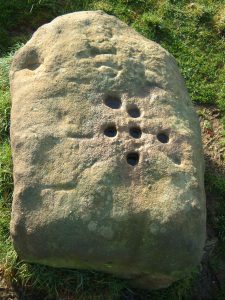Monday 20 April 2020

Eyam’s Riley graves – a whole family buried by the mother who gave them all the plague
When all this finishes, if it ever does, my first stop will be the UK’s Peak District. It may have been England’s first National Park, it may have been where freedom to roam was created in 1932, but it was also where the most perfect example of quarantine and self-sacrifice was created. That was more than 350 years ago.
The village was Eyam, the year 1665, and a damp bundle of cloth had arrived from London for the local tailor. It was late August, the time for Eyam Wakes Week, a religious festival that took place every year and continues to this day. A travelling tailor, George Viccars, had appeared in Eyam to help make clothes for the festival. He was boarding with a miner’s widow, Mary Hadfield (formerly Cooper), her new husband Alexander, and her two sons, Edward (aged 4 years) and Jonathan (aged 12 years). George Viccars, it is said, took hold of the bundle of cloth and unwrapped it, to dry before the hearth. It was an opening that released hidden fleas, which were infested with a bacterium called Yersinia pestis. That is the bug that causes bubonic plague. Eyam’s troubles had begun.
By 7 September 1665, George Viccars was dead as the first of Eyam’s plague victims. By 22 September Edward had perished, by 2 October Jonathan had died, and one year later, on 3 August 1666, Alexander had died as well. Mary, an Eyam local, was the only survivor although from the plague she eventually lost 13 relatives. The village lost a total of 260 inhabitants during that time from a population of only 350. Alexander’s death, although tragic, as it left his wife a double widow, took place during the plague’s second wave of infection. This wave was more virulent than the first.
Eyam flags up many questions, far more than their answers. Why did Mary Hadfield not die after losing so many relatives? She was in the same building as George Viccars who had started it off. And how about Elizabeth Hancocke who lived in a house in Riley Field with her husband and six children, on the edge of the village? She buried all seven in only eight days in August 1666, during the aggressive second wave. Imagine losing your whole family and burying each one with your own hands. The lesson? It is said Elizabeth brought the infection to her own family through a villager’s body that she helped to bury. Elizabeth remained unharmed.

William Mompesson, who created a rigid system of quarantine (Museums Sheffield)
Or, Marshall Howe, the village gravedigger, who handled so many infected bodies and yet saw the plague out in one piece? There is no logic in disease transmission. They saw it then with the plague, we see it now with Covid-19. It is a shame that no one knows how a disease will affect them until they actually acquire it. If we knew the effects would be minimal, we would be attending Covid parties in the hope we would be rendered immune. Sadly, no such luck with Covid-19.
The vicar in Eyam at the time of the plague was William Mompesson, who advocated the strictest of quarantines when the second wave struck. He had let the first one pass. Quarantine meant that no one was to enter or leave the village until the disease had vanished. Families were to bury their own dead, and church services were relocated outdoors to a place called Cucklett Delph. During worship, villagers and families were to separate themselves to reduce the chances of infection. Does some of that sound familiar? Deliveries to the village were left either beside a Boundary Stone, or near what is now called Mompesson’s Well. The Boundary Stone carried six perfectly drilled holes, which can still be seen to this day. It was in these holes that coins were left for the visiting tradesmen, the holes being filled with vinegar to make sure the cash was sterile.
William Mompesson’s wife, Catherine, stayed by her husband’s side throughout this catastrophe, but became a victim herself during the second wave in 1666. She perished on 25 August that year. She need not have done so, as in June 1666, William Mompesson sent his own children to Sheffield, 14 miles away, for their safety. Catherine refused to go, remained by her husband’s side, and was dead two months later. In total, Eyam’s plague lasted 14 months, the last death being in December 1666. The village’s self-imposed quarantine has become globally famous, as it prevented the disease from spreading to the surrounding areas. It was a wonderful example of self-sacrifice, as the quarantining was not to the advantage of the residents of Eyam. It was about saving others and nothing about saving themselves.
Once Covid-19 is done and dusted, should that Utopia one day be reached, Eyam is worth a visit. Yet if you go, be prepared to be both interested and depressed. The area may be scenic, the way underfoot generally kind, with plenty of walks around it, but I found it a difficult place to feel happy. There has simply been too much death, even if that was more than three centuries in the past. Full credit to those who now live there as they seem a happy bunch.

Boundary Stone where coins were left in holes filled with vinegar
Yet stand in Church Street, which leads past the village’s St Lawrence’s Church, and look at the signs outside various houses. There it is possible to trace the arrival and spread of the plague, from Plague Cottage, to Rose Cottage, the Lydgate Graves and so many more. Eyam is said to be haunted, too, and attracts ghoul-spotters from around the world. The Miners Arms, named thanks to the many meetings held by the local lead and fluorspar (the mineral form of calcium fluoride) miners who were active in the area, is spooked by several ghosts and is supposed to be the most haunted building in the village. It is said there are the two young girls who died in a fire on the site before the hostelry was constructed more than 300 years ago. There is also the ex-landlady who was murdered by her husband and now roams the corridors at night in her old-fashioned dress, which rustles as she passes. Plenty of guests overnighting at the Miners Arms dash home before breakfast. The plague cottages themselves are haunted by various spirits, including a lady in a blue smockwho is said to wake folk up at night. Eyam Hall is also haunted, by the ghost of Sarah Mills, a lady servant who drowned in a well. To cap it all, the Hall is also said to house the spirit of an old man who died in an upstairs room. The door to that room is now kept permanently sealed.
Eyam is a perfect example of quarantine and well worth a visit, especially once Covid-19 joins history. Of course, it depends if you are up to a good haunting, as Eyam has it all.
